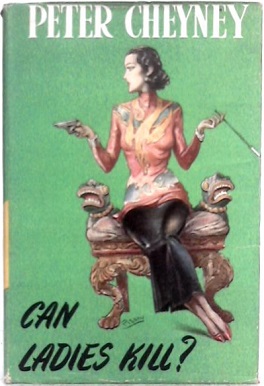
Can Ladies Kill? is a crime novel by British author Peter Cheyney first published in 1938 by William Collins, Sons & Co. Ltd. Set in San Francisco and featuring Cheyney's creation, G-Man Lemmy Caution, it belongs to the hardboiled school of crime writing.

The Curse of Doone is a 1928 mystery thriller novel by the British writer Sydney Horler. It also has element of horror about it. It was published in America in 1930 by The Mystery League.

G-Man at the Yard is a 1946 thriller novel by the British writer Peter Cheyney. It is the final entry in the popular series of novels featuring the FBI agent Lemmy Caution. It was republished posthumously in 1953 following his death in 1951, now also including three short stories. Unlike many other novels by Cheyney it was never made into a film.

I'll Say She Does is a 1945 thriller novel by the British writer Peter Cheyney. It is the tenth in his series of novels featuring the FBI agent Lemmy Caution. Later editions of the book are generally titled I'll Say She Does!
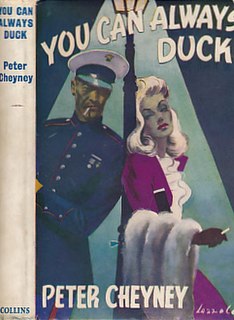
You Can Always Duck is a 1943 thriller novel by the British writer Peter Cheyney. It is the ninth in his series of novels featuring the FBI agent Lemmy Caution. The action takes place in wartime London where Caution is on the trail of a gang of black marketeers who have got mixed up in espionage. It was one of a number of films and novels of the period that made use of the booming black market for their setting.

Never a Dull Moment is a 1942 thriller novel by the British writer Peter Cheyney. It is the eight in his series of novels featuring the FBI agent Lemmy Caution. Cheyney had become known for his hardboiled style, similar to that of Raymond Chandler.

Your Deal, My Lovely is a 1941 thriller novel by the British writer Peter Cheyney. It is the seventh in his series of novels featuring the FBI agent Lemmy Caution. Much of the action takes place in wartime London. Caution is called in to investigate the disappearance of a prominent scientist.

You'd Be Surprised is a 1940 thriller novel by the British writer Peter Cheyney. It is the sixth in his series of novels featuring the FBI agent Lemmy Caution. Unlike several of the others it has not been adapted for film.
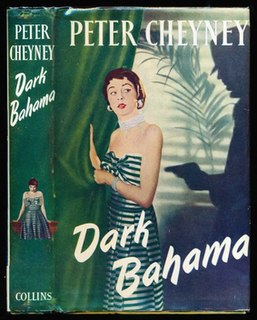
Dark Bahama is a 1950 thriller novel by the British writer Peter Cheyney. It was the second in a trilogy featuring the private detective Johnny Vallon, a hard-drinking former army officer. The story also features Quale, the head of British intelligence who appears on several other novels by Cheyney. Much of the action takes place in a fictional island in the Bahamas and nearby Miami in Florida.

Ladies Won't Wait is a 1951 spy thriller novel by the British writer Peter Cheyney. It is a sequel to the 1945 novel Sinister Errand and portrays the continued adventures of Michael Kells, a half-American, half-British secret agent. It was published in the United States under the alternative title Cocktails and the Killer.

Night Club is a 1945 crime thriller novel by the British writer Peter Cheyney. It is often better known by its alternative title Dressed to Kill, the name by which it was published in the United States and subsequent British versions. As with other Cheyney novels it features a hardboiled hero, and dialogue influenced by American-based writers such as Raymond Chandler.

Dark Duet is a 1942 spy thriller novel by the British writer Peter Cheyney. Cheyney had become known for his hardboiled crime thrillers featuring Lemmy Caution and Slim Callaghan, but this novel was his first fully-fledged espionage novel. The novel is set in wartime London, Lisbon and Ireland. It was published in the United States with the alternative title The Counterspy Murders.
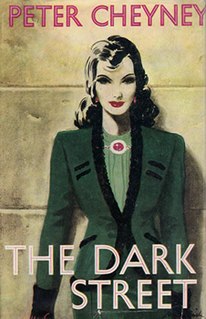
The Dark Street is a 1944 thriller novel by the British writer Peter Cheyney. It was published in the United States by Dodd, Mead with the alternative title of The Dark Street Murders. It follows on from both the 1942 novel Dark Duet and the 1943 novel The Stars Are Dark and features his recurring head of British counter intelligence Quale as well as the spy Shaun O'Mara. It begins in wartime occupied Paris before moving to London.

The Stars Are Dark is a 1943 spy thriller novel by the British writer Peter Cheyney. It was published in America with the alternative title The London Spy Murders. It follows on from the 1942 novel Dark Duet focusing on British counter intelligence operations during the Second World War, and introduces the character of Quale a senior British intelligence officer would appear in several novels.

Dance Without Music is a 1947 thriller novel by the British writer Peter Cheyney. While Cheyney had gained his reputation with series about two celebrated characters Lemmy Caution and Slim Callaghan, he also wrote several popular stand-alone novels about hardboiled private detectives such as this. It was serialised in Britain by The News of the World. In the United States it was published by Dodd Mead in 1948.
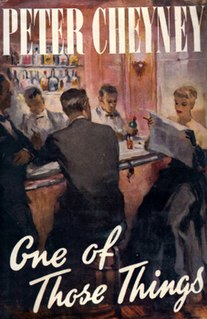
One of Those Things is a 1949 thriller novel by the British writer Peter Cheyney. Although best known for his series featuring Lemmy Caution and Slim Callaghan, this was one of several stand-alone novels he wrote featuring hardboiled private detectives. It was also published under the alternative title Mistress Murder.
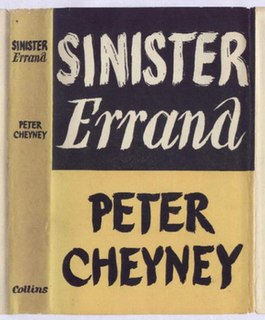
Sinister Errand is a 1945 spy thriller novel by the British writer Peter Cheyney. Cheyney known for his creations Lemmy Caution and Slim Callaghan, introduced a new character the half-American secret agent Michael Kells. It was followed by a sequel Ladies Won't Wait in 1951.

Up the Ladder of Gold is a 1931 thriller novel by the British writer E. Phillips Oppenheim. He dedicated the work to the comedy writer P.G. Wodehouse. It represented the apex of Oppenheim's portrayal of the great man as a dynamic force.

A Lost Leader is a 1906 politically-themed novel by the British writer E. Phillips Oppenheim. Later better known for his thrillers it was one of several novels Oppenheim wrote at the time centred on "social political life". In it a potential Liberal Party politician, Lawrence Mannering, is lured back from his country estate to London to revive the party's fortunes.

Mysterious Mr. Sabin is a 1898 spy thriller novel by the British writer E. Phillips Oppenheim. It was the first spy novel by Oppenheim, a genre which he came to dominate during the First World War and interwar era. Revolving around a plot of a Frenchman selling British military secrets it became a bestseller, establishing him as a popular writer. It has been described as the novel "that launched Oppenheim's career of xenophobic espionage fantasy". It contains elements of invasion fiction, a common genre theme at the time.




















